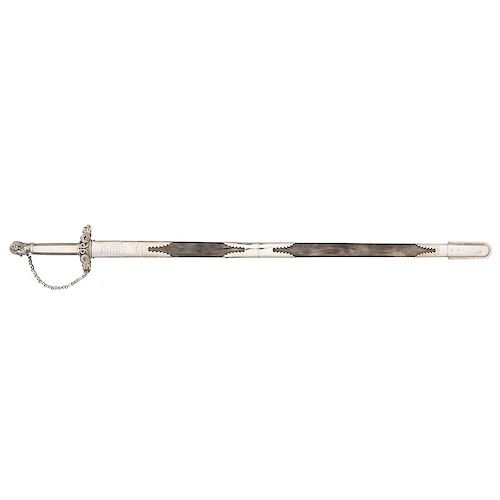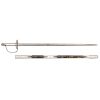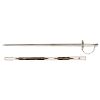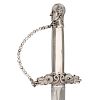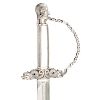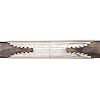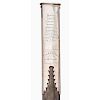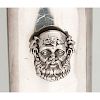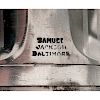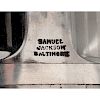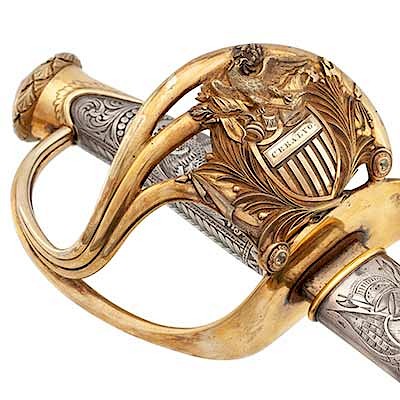Samuel Jackson Presentation Sword to Major Daniel H. McPhail
About Seller
6270 Este Ave.
Cincinnati , OH 45232
United States
With offices in Cincinnati, Cleveland and Denver, Cowan’s holds over 40 auctions each year, with annual sales exceeding $16M. We reach buyers around the globe, and take pride in our reputation for integrity, customer service and great results. A full-service house, Cowan’s Auctions specializes in Am...Read more
Two ways to bid:
- Leave a max absentee bid and the platform will bid on your behalf up to your maximum bid during the live auction.
- Bid live during the auction and your bids will be submitted real-time to the auctioneer.
Bid Increments
| Price | Bid Increment |
|---|---|
| $0 | $25 |
| $500 | $50 |
| $1,000 | $100 |
| $2,000 | $250 |
| $5,000 | $500 |
| $10,000 | $1,000 |
| $20,000 | $2,500 |
| $50,000 | $5,000 |
| $100,000 | $10,000 |
About Auction
Oct 30, 2018
Cowan's is honored to present the Magnificent Sword Collection of William Koch in its two-day firearms, militaria, and American history auction, with a focus on the Civil War. Cowan's Auctions dawnie@cowans.com
- Lot Description
Samuel Jackson Presentation Sword to Major Daniel H. McPhail
31.25" tapered, double-edged spear-point blade with nearly full-length, narrow median fuller. 6.375" octagonal silver hilt with checkered angled flats and an elegantly executed bust of George Washington as the pommel cap. 3.75" wide cross guard terminating in exquisitely chiseled Chinese dragons. Chain knuckle bow secured to loop through a small loop secured to Washington's jaw line and another loop in the mouth of the lower dragon. Both ricassos stamped in three lines: SAMUEL / JACKSON / BALTIMORE . Blade decorated on both sides with 6 narrow acid etched lines, about 12" long, half on either side of the fuller, terminating in three angled chevron-style lines. Silver-plated metal scabbed with silver mounts with the frog button in the form of Zeus' head. The obverse middle mount is engraved with a six-line presentation that reads: Presented to BVt MAJ. DANIEL H. McPHAIL, 5th Infantry U.S. Army / by Citizen of Baltimore as a / testimonial of their esteem for / his services as Soldier in the / War with Mexico as a Citizen of Baltimore / Feb. 22, 1849 . The reverse of the upper mount is engraved with a series of battle honors that reads from top to bottom: Monterey, Vera Cruz, San Antonio, Churubusco, Molina del Rey, Chapultepec, Garita de Belin, Garita de San Cosme, City of Mexico . The lower portion of the mount reads: Col. D.H. McPhail / to / G.H. Coutts / January 30, 1884 . This fabulous sword was previously in the famed Philip Medicus collection, and is published in American Swords from the Collection of Philip Medicus by Norm Flayderman and Stuart C. Mowbray. This sword is described on page 14 and pictured on page 15 as Figure 3a in Plate 3. An incredible sword in fantastic condition with impeccable provenance.
Something of an anomaly for the time Baltimore native Daniel H. McPhail (1813-1884) was appointed 2nd lieutenant in the 5th U.S. Infantry on march 8, 1837 without formal Military Academy training. During this time the regiment served in the upper Midwest engaged in isolated garrison duty while building a number of military posts to monitor British presence along the Canadian border. The 5th Infantry played only a minor role in the Black Hawk War in 1832 and was not called upon for active service during he Seminole War. After years of enduring frontier monotony McPhail was promoted to 1st lieutenant in May 1840. The 5th United States Infantry would see considerable combat during the Mexican War as evidenced by the nine battle honors engraved on McPhail's sword. The Mexican War had been precipitated by President John Tyler's annexation of Texas, increasingly populated by American settlers, in March 1845. President Polk committed US regular troops to Texas to counter any Mexican attempt to alter the course of Manifest Destiny. General Zachary Taylor had orders to assemble a force in the contested territory that divided the two counties, the area between the Nueces River (the Mexican delineation) and the Rio Grande (United States delineation). Five companies of the 5th Infantry reported to Taylor at Corpus Christi on October 11, 1845. Taylor's Army of Occupation as it was called, numbered about 2300 men, all regulars that included parts of five infantry regiments, three light batteries and a battalion of foot artillery, plus the 2nd Dragoons begin to concentrate on the Rio Grande opposite Matamoras. Volunteers regiments from the United States were still making their way to Texas. Taylor's main supply depot was at Point Isabel and upon receiving word from his scouts that a body of Mexicans were threatening his line of supply, Taylor immediately marched to Point Isabel but met with no opposition. After securing the camp Taylor formed up and started the march back to Matamoros. On May 8 the American Army ran into a large body of Mexican regulars under the command of General Mariano Arista at Palto Alto. The action begin in the heat of the afternoon with American artillery bearing the brunt of the fighting. Later in the afternoon a "large body of Mexican cavalry" bore down on the 5th Infantry "with a view toward cutting off out wagon train." The 5th reformed to meet the massed cavalry charge "with the most perfect tranquility, and a discharge of musketry told us their fate. They fled precipitately, leaving men, horses and guidons on the field." The action ended around 7pm when the entirety of the enemy retreated. The next day Taylor fought the Mexicans at Resaca de la Palma. Mexican entrenchments fortified with artillery and flanked by concealed infantry ran obliquely along a natural ravine nearly parallel to road on which Americans advanced. Mexican artillery fire was heavy enough so that Taylor ordered a squadron of Dragoons under Charles E. May to capture the guns. The momentum of the charge was such that May's dragoons overran the Mexican battery and captured a Mexican general. Concentrated Mexican infantry forced the outnumbered dragoons back, but the 5th and 7th Infantry quickly formed up and charged the ravine at the point of the bayonet driving the Mexicans east of the road "in utter route before them." West of the road the 4th Infantry flanked a Mexican Battery and held off a major counterattack by infantry putting flight to Arista's now demoralized remnants who surged back across the Rio Grande with many soldiers drowned. Eight Meixian artillery peices were captured as trophies along with several hundred prisoners. American looses during the two battles amounted to 38 men killed and 113 wounded. On July 10, 1846 McPhail was promoted to captain of Company B.
Taylor's army occupied Matamoras and by September was concentrated in Monterey taking in reinforcements into camp, fresh regiments of volunteers from the United States, that immediately began drilling with the regulars. Assigned to Worth's Division, the 5th Infantry fought at Monterey in the second line and was not actively engaged until coming up to support the tenuous American hold on Federation Hill. The 5th Infantry commanded by Major Martin Scott went into action and the lead company led by Captain C. F. Smith "drove the enemy from a battery and breastworks nearest to us, but he then discovered another work called Fort Soldado, several hundred yards further on, and there was great emulation among the regiments to see which should reach it first. The 5th Infantry won the race and went in over the parapet at one end as the Mexicans went out the other." A lull in the fighting then commenced as Taylor's army occupied Monterey, having granted Ampudia's defenders exceedingly favorable terms. In January 1847 the veteran 5th Infantry numbering 410 all ranks was transferred to Winfield Scott's Army for further operations in the South. The regiment did not participate in the siege of Vera Cruz and played only a minor role in the battle of Cerro Gordo in which the elite topographical engineers first reconnoitered and then supervised construction a narrow path that allowed Scott to flank strong Mexican positions, and then attack from behind forcing the surrender of a large portion of Santa Anna's army. Worth's division including the 5th Infantry came up just as the battle ended and was not engaged. On August 22, the Worth's fresh division took the point and on April 22, 1847 captured the San Carlos fortress at Jalapa including artillery and supplies. Scott's army then occupied Puebla on May 15 where it reorganized and accumulated supplies before continuing the advance toward Mexico City on August 7.
On August 20, 1847 numbering about 385 men the 5th Infantry fought at the battle of Churubusco. The 2nd Brigade of Worth's division effected a flanking movement which forced the Mexicans to evacuate their works at San Antonio. The brigade kept close at the heels of the fleeing enemy along the causeway to Churubusco. Colonel Clarke commanding the regiment went down while Captain McPhail also sustained a wound, "his uniform being pierced with bullet holes in the front and across the shoulders." Advancing before the tete de pont Lt Colonel Scott ordered the regiment to move to the right around the strongpoint where the regiment attacked and "was among the first to storm (the position) and drive the enemy's troops toward the city." The American army then went into camp until September 8 while General Scott sought to negotiate surrender terms with the Mexicans. On September 8 American troops moved up to Molino del Rey where a canon foundry was though to be in production. At dawn a picked assault force of some 500 men including a 100 man detachment of the 5th Infantry attacked the outlying buildings over level ground and were met by concentrated Mexican artillery fire. As the American force were driven back with heavy casualties, Mexican infantry joined the attack before American reinforcements and artillery blunted the determined enemy foray. Meantime, General Worth fed more troops into the assault and finally forced the gates of the foundry while fending off two determined Mexican counterattacks followed by two hours of bloody room to room fighting before the Mexicans were finally expelled. The Americans found no cannon at the foundry and by early afternoon had return to their own lines. The 5th Infantry had suffered 30 killed and 111 wounded at Molino del Rey, nearly 40% of those engaged.
Within hailing distance of the Molino del Rey stood the fortress of Chapultepec on a key promontory defending the gates to Mexico City from the west. General Scott quickly regrouped and on September 12 put the whole of his artillery to work bombarding the citadel. The Mexican defenders including those positioned outside in walled redoubts amounted to about 1,000 men including some 200 young military cadets. The next day Scott had assembled three assault columns composed mostly of regular troops with some 250 men picked from Worth's division. American artillery fire ceased and all along the front the infantry attacked. Worth later reported that, "The moment had now arrived for the final and combined attack upon the last stronghold of the enemy in my quarter; it was made by our men springing as if by magic, to the tops of the houses into which they had patiently and quietly made their way with bar and pick, and to the utter surprise and consternation of the enemy, opening upon him, with easy range, a destructive fire of musketry. A single discharge, in which many of his gunners were killed at their pieces, was sufficient to drive him in confusion from his breastworks, when a prolonged shout from out brave fellows announced that we were in possession of the Garita of San Cosine, and already in the city of Mexico. In fact, American volunteer troops had also played a prominent role in the battle - regiments from New York and Pennsylvania - and it was the New Yorker's who raised their flag after taking the surrender of General Bravo at 9am in the morning. On September 14, 1847 Mexico City surrendered bringing major combat operations to a close. Of the 5th Infantry 30 officers had served in Mexico with half being killed or wounded. Seven officers were twice brevetted for "gallantry and meritorious conduct" while eleven received a single brevet. McPhail's brevet promotion to major was awarded for the battles of Contreras and Churubusco along with a slight wound. A year and a half later Brevet Major Daniel H. McPhail resigned from the army on April 30, 1849 after twelve years of service and a lifetime of campaigning.
In addition to this fine presentation sword presented by "the Citizens of Baltimore" to an esteemed combat officer, the Maryland Legislature by Resolution No. 17, Acts of 1849, recognized their native son "for his bravery and gallantry in eleven battles during the recent conflict of arms with the Republic of Mexico."
With the advent of the Civil War, Daniel McPhail's former commander in Mexico, General Winfield Scott, offered a commission which the fifty-eight year old McPhail duly accepted. Major McPhail was then commissioned on June 1, 1861 into the US Volunteer Paymaster's Department. During the war the major, at various times, served on staffs of Generals Rosecrans, Garfield, and Hayes seeing the end of hostilities while acting as paymaster at Wheeling, West Virginia. McPhail was brevetted to lieutenant colonel on March 13, 1865 for "gallant and distinguished service" and remained in the army for nearly four more years posted to New Orleans and Charleston before finally mustering out January 1, 1869. Little is known of McPhail later life other than at some point he settled in New York City and was said to travel extensively. He never married. At seventy one years old, the soldier in two wars died in Brooklyn on January 30, 1884 "at the residence of his sister" and was buried in the local Green-Wood Cemetery (Lot 4049, Sec. 23).Exceptional. Blade retains nearly all of its original bright polish and lightly etched geometric decoration. Hilt with similar bright polish. Grip with some very minute wobble on the tang. Scabbard very fine, with some minor scuffs and light scratches on the mounts, mostly noticeably some scratches over the end of the last line of the presentation on the middle mount. Also showing some thinning and tarnishing of the body plating. Overall all a really spectacular, one of a kind Mexican War presentation sword whose elegance lies in its overstated simplicity.Condition
- Shipping Info
-
Buyers are required to pay for all packing, shipping and insurance charges. Overseas duty charges are the responsibility of the successful Bidder. Be aware that for larger and/or valuable items, shipping charges can be substantial. - If there is no shipping amount on listed your invoice, you will need to make arrangements to pick up or ship your purchase through an alternative shipping company. Our shipping department can be contacted at 513.871.1670 (ext. 219) or email shipping@cowans.com. - Shipping charges include insurance for your order while in transit. If you have private insurance we will adjust your charge to include only packing and shipping. - Please allow 14 – 21 days after payment to package and ship your purchase as carefully as possible.
-
- Buyer's Premium



 EUR
EUR CAD
CAD AUD
AUD GBP
GBP MXN
MXN HKD
HKD CNY
CNY MYR
MYR SEK
SEK SGD
SGD CHF
CHF THB
THB